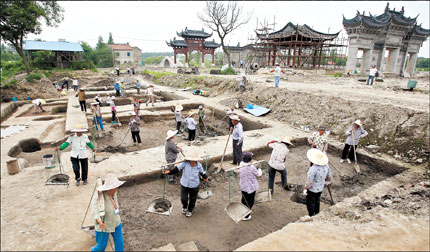Oldest city archeology site opens
 0 Comment(s)
0 Comment(s) Print
Print E-mail Shanghai Daily, June 8, 2012
E-mail Shanghai Daily, June 8, 2012
The Guangfulin archeological site in Songjiang District, where Shanghai's earliest known residents lived about 5,000 years ago, opened to the public for the first time yesterday.
More than 100 local residents and media reporters visited the late Neolithic period (c. 80th century - 20th century BC) site covering 250,000 square meters, the city's largest and most important archaeological site that had been closed since it was discovered in 1958.
It was also the first time in China that an archaeological site had been opened to the public before the excavation was finished.
"The site has proved the city was a cultural center thousands of years ago rather than a fishing village with a history of only hundreds of years that has been widely assumed before," said Chen Jie, deputy director of the archeology department of the Shanghai Museum, who has led the digging at the site.
The city's cultural relics management authority yesterday announced the unearthing of a 24-centimeter-high bronze ritual vessel from the Western Zhou Dynasty (c. 11th century - 770 BC) this year, the most important discovery from the site so far.
It is also the largest and most well-preserved bronzeware unearthed in the city.
"The vessel proved the area had been rich and a cultural center in the Western Zhou Dynasty because ordinary villages usually used pottery wares," said Chen.
The vessel is now being restored in the museum and will be exhibited there by the end of the year.
The site is divided into hundreds of 10-meter square pits where more than 700 workers and experts are digging every day.
A relic of an old residential house is another centerpiece of the site, though only some bricks and debris of kitchenware remained. Chen said experts found the ancestors had been able to heat up clay to build houses and divided the 100-square-meter building into different rooms for various functions.
"The place likely was an administrative center where nobles or governors of the area were living," said Gao Menghe, the archeological team's leader from Fudan University.
Another highlight is a grave where four tombs were placed together. Some jade articles were unearthed from the grave.
The archeological team, composed of experts and students from the museum and universities, plans to finish digging a 15,000-square-meter area by the end of June, said Gao.
A new museum near the site that will house artifacts unearthed there will also be complete by the end of this month. Unearthed pottery containers, stone ploughs and kilns will be displayed in the 80,000-square-meter complex to evoke the lifestyle of the ancient Guangfulin residents.
The site was discovered in 1958 by local farmers working on irrigation projects, but excavation did not begin until 1999. The excavation will be extended to surrounding areas in the future, Chen said.
But a major problem, he said, is lack of talent in China. The current archeological team has to dig for over 10 hours every day, he said.
"There are many schools and institutes to train archeologists but fewer of them will choose to do the job after graduation because of the hard work and low pay," he said.







Go to Forum >>0 Comment(s)